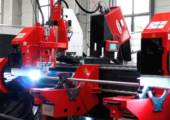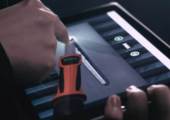-


在线留言
发送您的问题或需求,我们将尽快与您取得联系!
×
-
COMPLEX PHYSICS, EASE OF OPERATION
THE NEW MAGICWAVE POWER SOURCE
07/27/2020
TIG welding guarantees the weld seam quality required in pipeline construction, the food industry, or vehicle manufacturing. Aluminum is a material often used for this and many of the seams are welded manually. Fronius has developed the MagicWave digital power source for this purpose – and carefully examined and optimized the TIG process.

AC FOR ECONOMICAL ALU MINUM WELDING
When welding aluminum, it is necessary to use alternating current (AC) in order to continue to change the lectrode from plus to minus. The oxide layer surrounding the material only melts at around 2050 °C. When the electrode is set to positive, the electrons move from the workpiece into the electrode, rupturing the oxide layer in the process. Then the electrode is set to negative and the electrons moving into the workpiece generate heat – this is how the penetration required for the weld seam occurs.
QUICK POWER LO SS PREVENTION
If, however, the aluminum workpiece is already clean in one area and has no oxide layer, the positive half-wave in the current flow breaks off – the arc breaks. This results in a pause until the negative half-wave, which reintroduces heat into the workpiece. A new development by Fronius prevents the loss of power caused as a result: The device recognizes when no current can flow due to the missing oxide layer and automatically connects a negative half-wave. As a result, the weld pool does not cool down, penetration is more reliable, and the arc remains stable.
ELECTRODES IN TOP SHAPE
Another feature introduced by Fronius is the automatic cap-shaping during AC welding. This involves a certain current being sent through the tungsten electrode – depending on its diameter – for a certain amount of time so that it rounds off at the end in a “cap”. If it forms inaccurately, the arc becomes unstable and the weld seam quality drops. The latest method uses pulsating current, setting the liquid metal in motion, which makes the cap lighter and gentler for the electrode.
THE PERFECT WAVE EVERY TIME
For alternating current welding, the user has a choice of different half-wave settings. For example, the current can flow at a constant strength first in the positive space and then the negative space – this results in a hard rectangle. Another possibility comes in the form of gentle waves, similar to a sine curve. For most aluminum applications, the ideal choice is a combination of the two – a rectangle with rounded corners. MagicWave allows the user to choose from different waveforms and even combine them.
PERFECTION IN SIGHT
All of these developments help the welder to properly master the TIG process. The user-friendly menu control and option to set different languages make their work even easier. This leaves the user free to concentrate fully on welding a high-quality, clean seam.
-


 下载
下载
 会员中心
会员中心



 收起
收起


























